Abstract
The Dictyostelium discoideum developmental program is initiated by starvation and its progress depends on G-protein-regulated transmembrane signaling. Disruption of the Dictyostelium G-protein alpha-subunit G alpha 3 (g alpha 3-) blocks development unless the mutant is starved in the presence of artificial cAMP pulses. The function of G alpha 3 was investigated by examining the expression of several components of the cAMP transmembrane signaling system in the g alpha 3- mutant. cAMP receptor 1 protein, cyclic nucleotide phosphodiesterase, phosphodiesterase inhibitor, and aggregation-stage adenylyl cyclase mRNA expression were absent or greatly reduced when cells were starved without exogenously applied pulses of cAMP. However, cAMP receptor 1 protein and aggregation-stage adenylyl cyclase mRNA expression were restored by starving the g alpha 3- cells in the presence of exogenous cAMP pulses. Adenylyl cyclase activity was also reduced in g alpha 3- cells starved without exogenous cAMP pulses compared with similarly treated wild-type cells but was elevated to a level twofold greater than wild-type cells in g alpha 3- cells starved in the presence of exogenous cAMP pulses. These results suggest that G alpha 3 is essential in early development because it controls the expression of components of the transmembrane signaling system.
Full text
PDF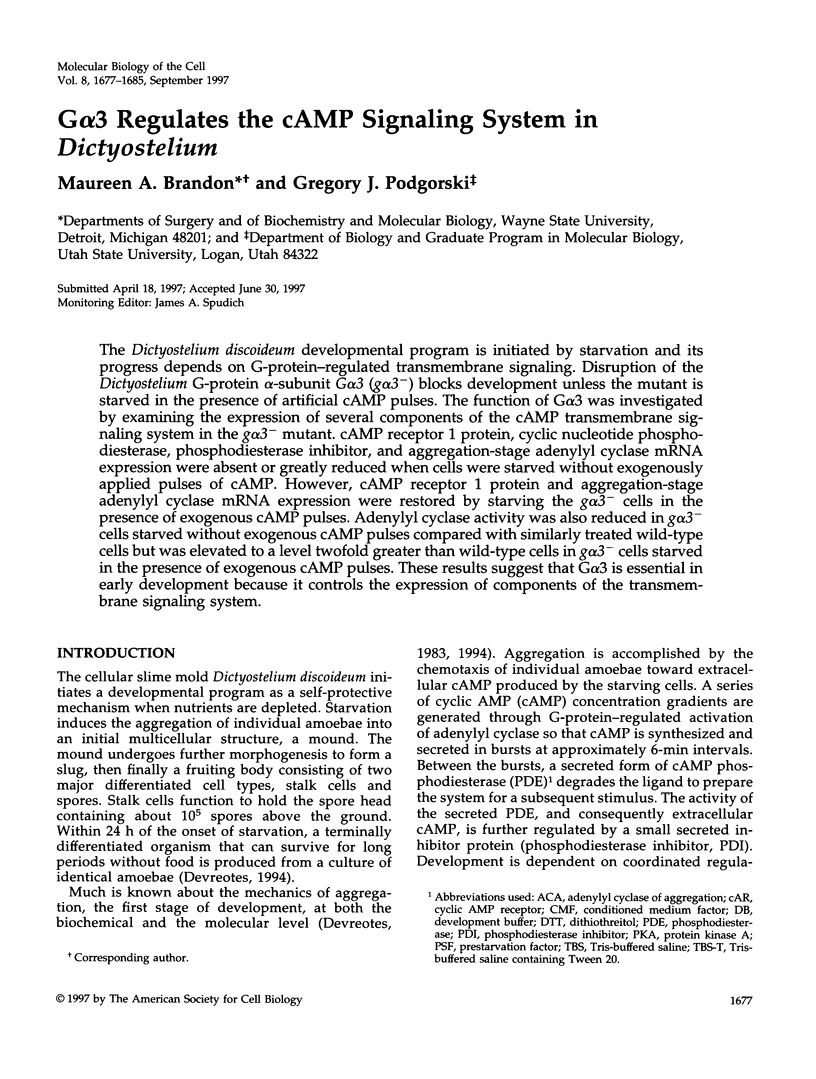
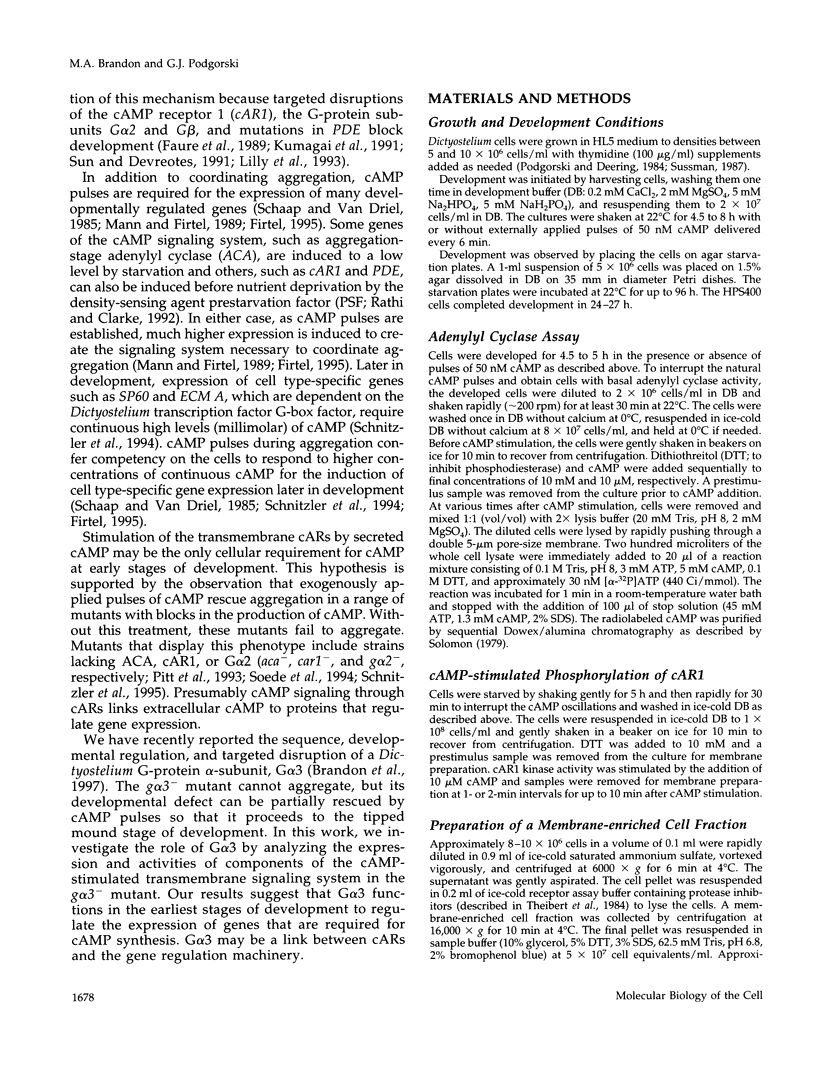
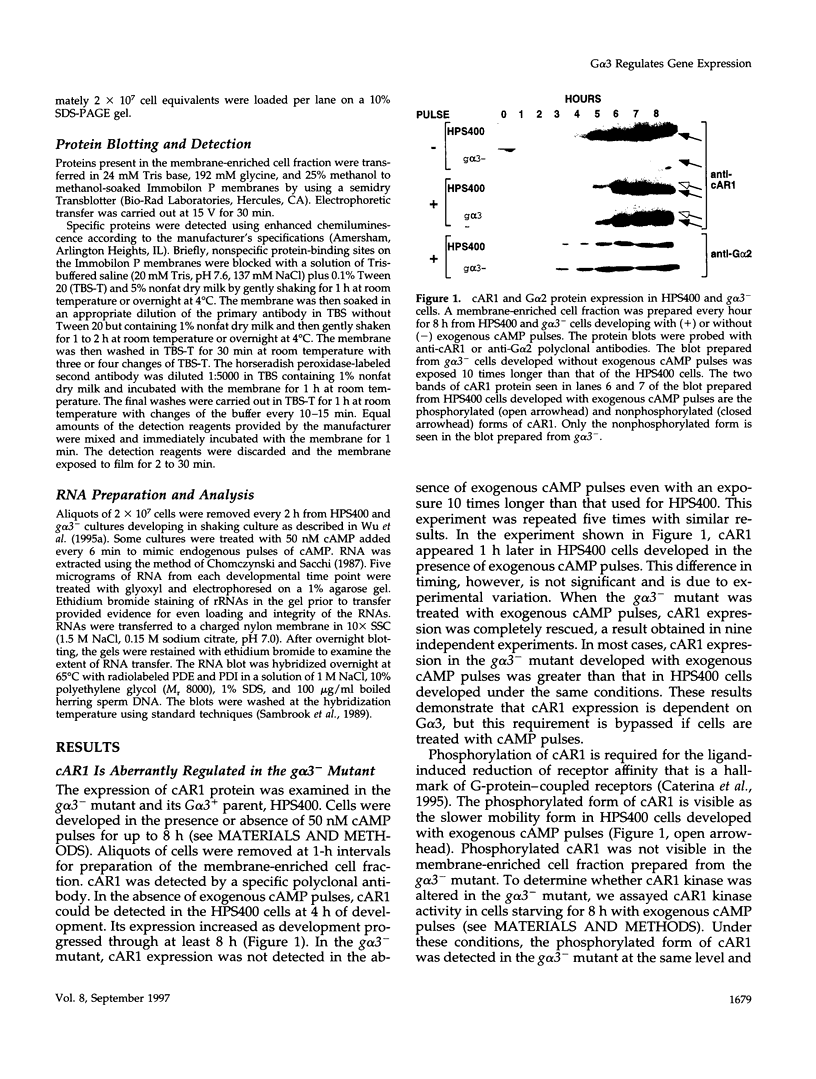
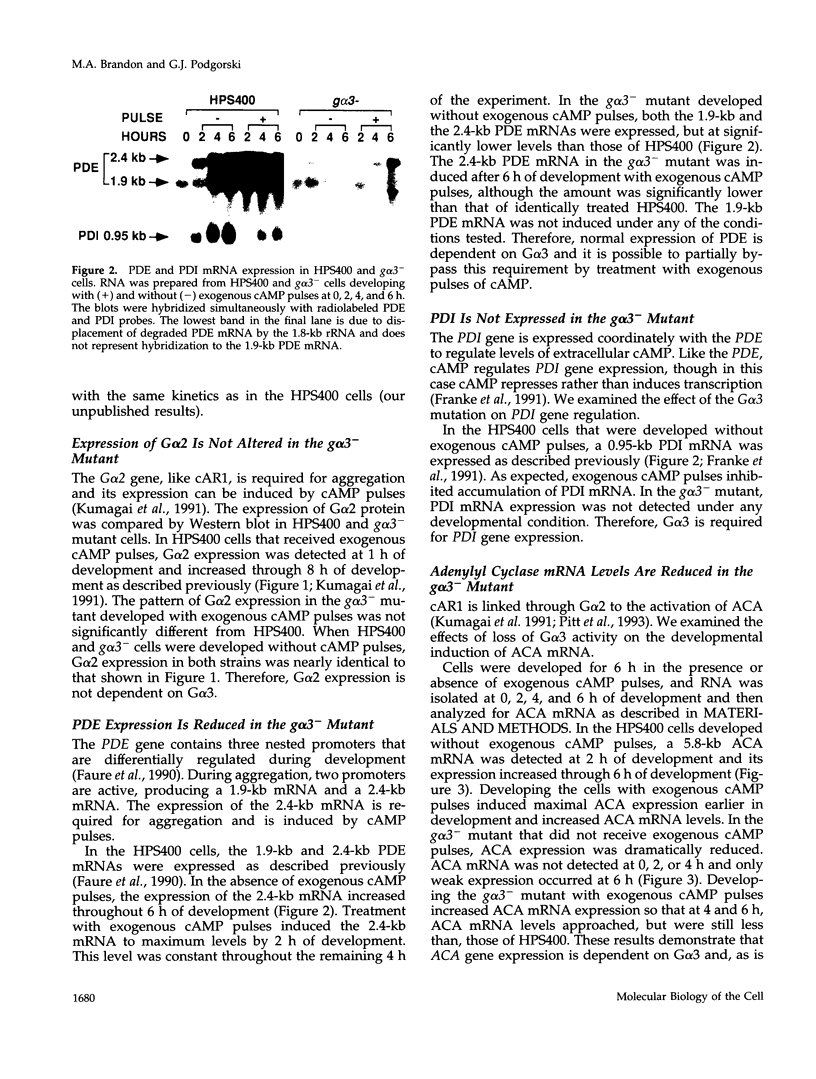
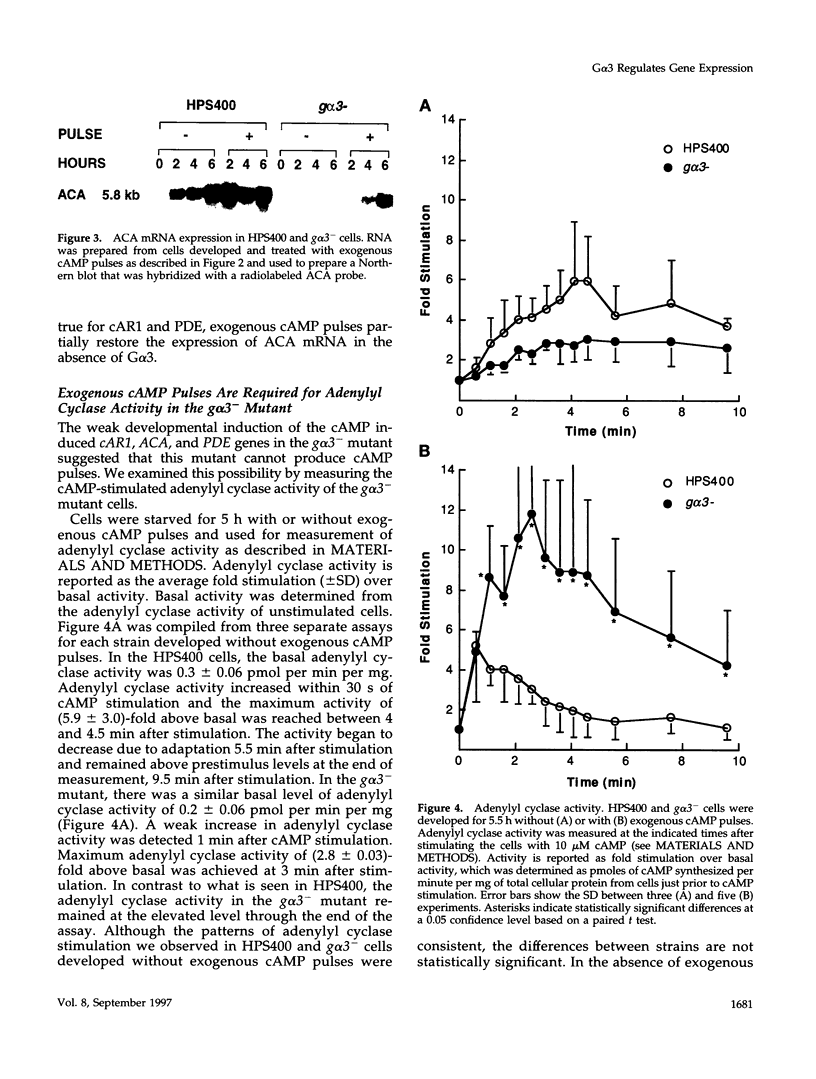
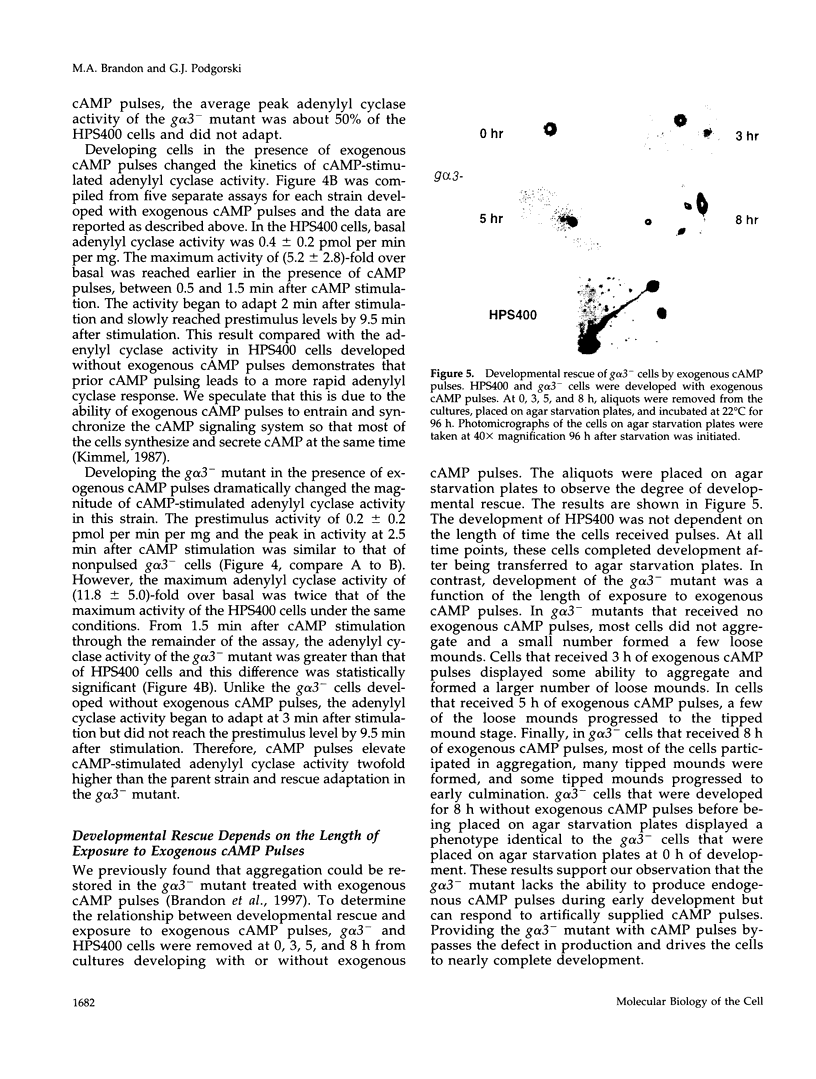
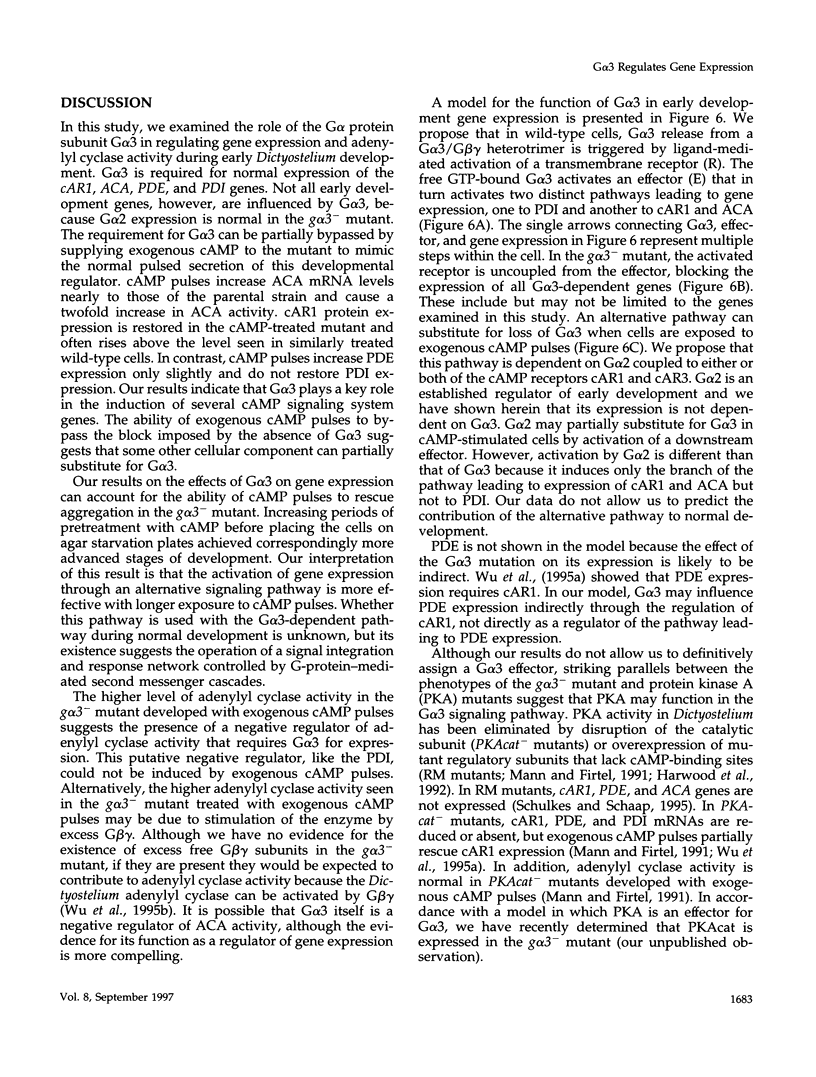
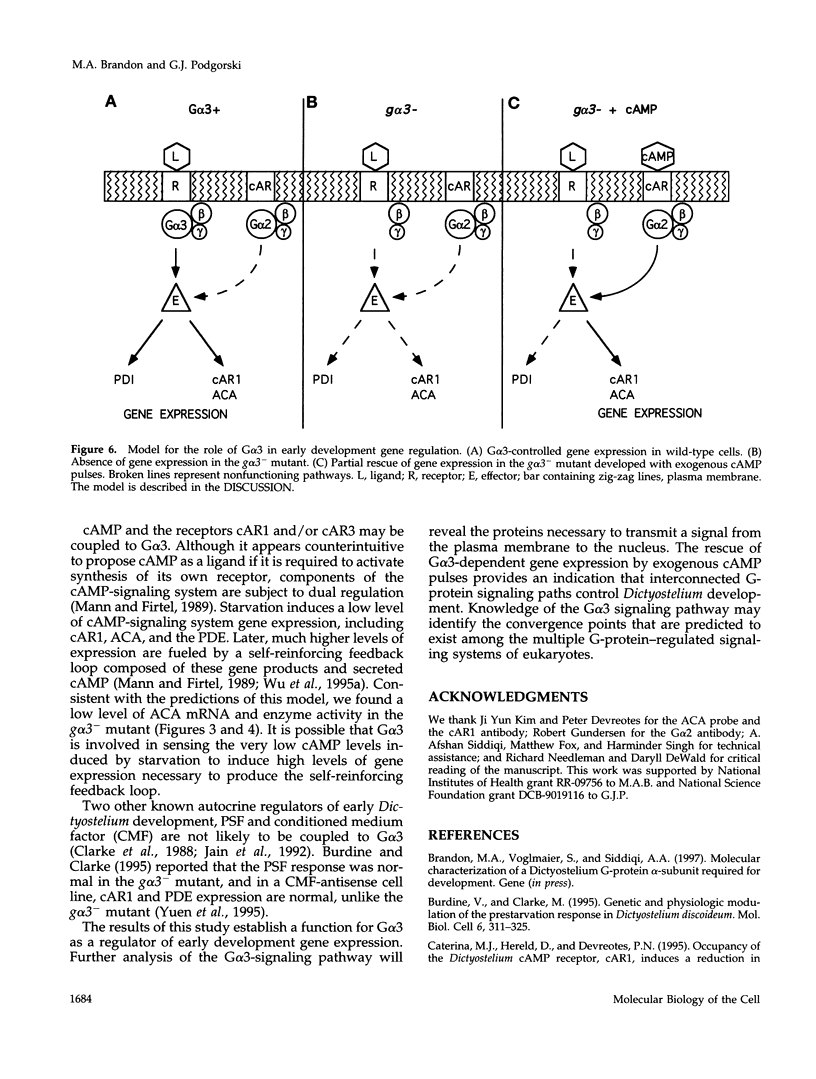
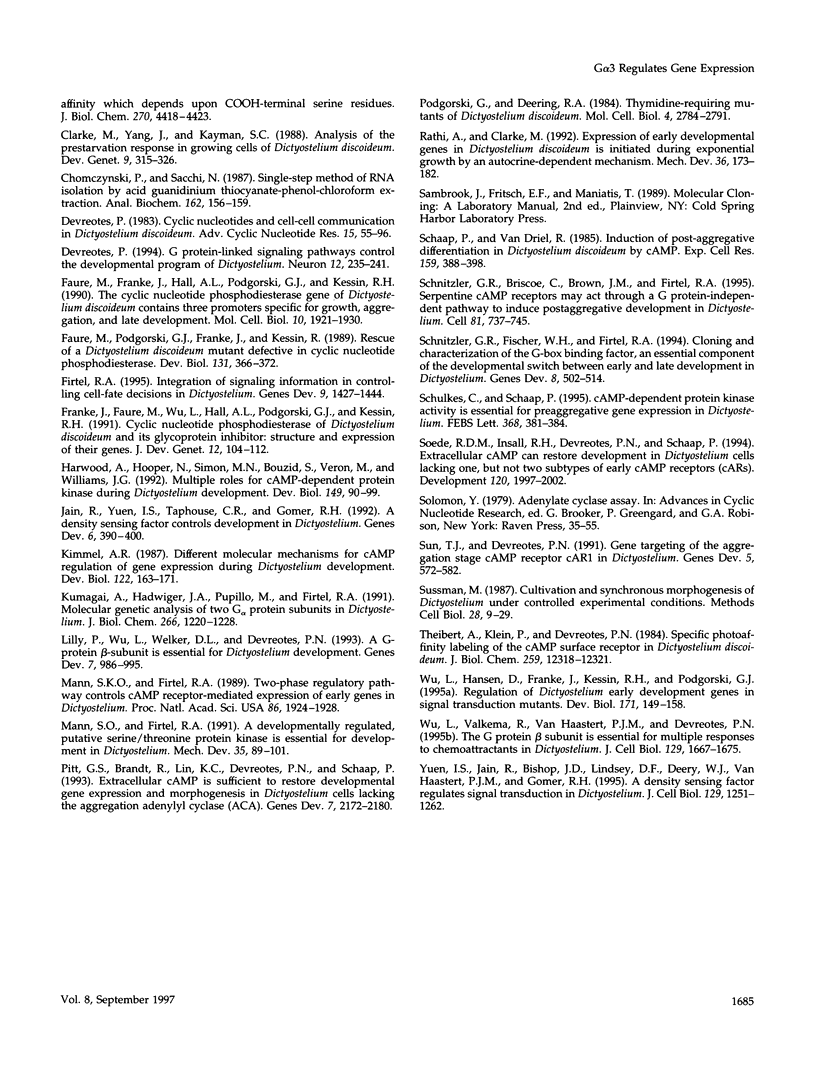
Images in this article
Selected References
These references are in PubMed. This may not be the complete list of references from this article.
- Burdine V., Clarke M. Genetic and physiologic modulation of the prestarvation response in Dictyostelium discoideum. Mol Biol Cell. 1995 Mar;6(3):311–325. doi: 10.1091/mbc.6.3.311. [DOI] [PMC free article] [PubMed] [Google Scholar]
- Caterina M. J., Hereld D., Devreotes P. N. Occupancy of the Dictyostelium cAMP receptor, cAR1, induces a reduction in affinity which depends upon COOH-terminal serine residues. J Biol Chem. 1995 Mar 3;270(9):4418–4423. doi: 10.1074/jbc.270.9.4418. [DOI] [PubMed] [Google Scholar]
- Chomczynski P., Sacchi N. Single-step method of RNA isolation by acid guanidinium thiocyanate-phenol-chloroform extraction. Anal Biochem. 1987 Apr;162(1):156–159. doi: 10.1006/abio.1987.9999. [DOI] [PubMed] [Google Scholar]
- Clarke M., Yang J., Kayman S. C. Analysis of the prestarvation response in growing cells of Dictyostelium discoideum. Dev Genet. 1988;9(4-5):315–326. doi: 10.1002/dvg.1020090413. [DOI] [PubMed] [Google Scholar]
- Devreotes P. N. G protein-linked signaling pathways control the developmental program of Dictyostelium. Neuron. 1994 Feb;12(2):235–241. doi: 10.1016/0896-6273(94)90267-4. [DOI] [PubMed] [Google Scholar]
- Faure M., Franke J., Hall A. L., Podgorski G. J., Kessin R. H. The cyclic nucleotide phosphodiesterase gene of Dictyostelium discoideum contains three promoters specific for growth, aggregation, and late development. Mol Cell Biol. 1990 May;10(5):1921–1930. doi: 10.1128/mcb.10.5.1921. [DOI] [PMC free article] [PubMed] [Google Scholar]
- Faure M., Podgorski G. J., Franke J., Kessin R. H. Rescue of a Dictyostelium discoideum mutant defective in cyclic nucleotide phosphodiesterase. Dev Biol. 1989 Feb;131(2):366–372. doi: 10.1016/s0012-1606(89)80010-7. [DOI] [PubMed] [Google Scholar]
- Firtel R. A. Integration of signaling information in controlling cell-fate decisions in Dictyostelium. Genes Dev. 1995 Jun 15;9(12):1427–1444. doi: 10.1101/gad.9.12.1427. [DOI] [PubMed] [Google Scholar]
- Franke J., Faure M., Wu L., Hall A. L., Podgorski G. J., Kessin R. H. Cyclic nucleotide phosphodiesterase of Dictyostelium discoideum and its glycoprotein inhibitor: structure and expression of their genes. Dev Genet. 1991;12(1-2):104–112. doi: 10.1002/dvg.1020120118. [DOI] [PubMed] [Google Scholar]
- Harwood A. J., Hopper N. A., Simon M. N., Bouzid S., Veron M., Williams J. G. Multiple roles for cAMP-dependent protein kinase during Dictyostelium development. Dev Biol. 1992 Jan;149(1):90–99. doi: 10.1016/0012-1606(92)90266-j. [DOI] [PubMed] [Google Scholar]
- Jain R., Yuen I. S., Taphouse C. R., Gomer R. H. A density-sensing factor controls development in Dictyostelium. Genes Dev. 1992 Mar;6(3):390–400. doi: 10.1101/gad.6.3.390. [DOI] [PubMed] [Google Scholar]
- Kimmel A. R. Different molecular mechanisms for cAMP regulation of gene expression during Dictyostelium development. Dev Biol. 1987 Jul;122(1):163–171. doi: 10.1016/0012-1606(87)90342-3. [DOI] [PubMed] [Google Scholar]
- Kumagai A., Hadwiger J. A., Pupillo M., Firtel R. A. Molecular genetic analysis of two G alpha protein subunits in Dictyostelium. J Biol Chem. 1991 Jan 15;266(2):1220–1228. [PubMed] [Google Scholar]
- Lilly P., Wu L., Welker D. L., Devreotes P. N. A G-protein beta-subunit is essential for Dictyostelium development. Genes Dev. 1993 Jun;7(6):986–995. doi: 10.1101/gad.7.6.986. [DOI] [PubMed] [Google Scholar]
- Mann S. K., Firtel R. A. A developmentally regulated, putative serine/threonine protein kinase is essential for development in Dictyostelium. Mech Dev. 1991 Sep;35(2):89–101. doi: 10.1016/0925-4773(91)90060-j. [DOI] [PubMed] [Google Scholar]
- Mann S. K., Firtel R. A. Two-phase regulatory pathway controls cAMP receptor-mediated expression of early genes in Dictyostelium. Proc Natl Acad Sci U S A. 1989 Mar;86(6):1924–1928. doi: 10.1073/pnas.86.6.1924. [DOI] [PMC free article] [PubMed] [Google Scholar]
- Pitt G. S., Brandt R., Lin K. C., Devreotes P. N., Schaap P. Extracellular cAMP is sufficient to restore developmental gene expression and morphogenesis in Dictyostelium cells lacking the aggregation adenylyl cyclase (ACA). Genes Dev. 1993 Nov;7(11):2172–2180. doi: 10.1101/gad.7.11.2172. [DOI] [PubMed] [Google Scholar]
- Podgorski G., Deering R. A. Thymidine-requiring mutants of Dictyostelium discoideum. Mol Cell Biol. 1984 Dec;4(12):2784–2791. doi: 10.1128/mcb.4.12.2784. [DOI] [PMC free article] [PubMed] [Google Scholar]
- Rathi A., Clarke M. Expression of early developmental genes in Dictyostelium discoideum is initiated during exponential growth by an autocrine-dependent mechanism. Mech Dev. 1992 Feb;36(3):173–182. doi: 10.1016/0925-4773(92)90068-u. [DOI] [PubMed] [Google Scholar]
- Schaap P., van Driel R. V. Induction of post-aggregative differentiation in Dictyostelium discoideum by cAMP. Evidence of involvement of the cell surface cAMP receptor. Exp Cell Res. 1985 Aug;159(2):388–398. doi: 10.1016/s0014-4827(85)80012-4. [DOI] [PubMed] [Google Scholar]
- Schnitzler G. R., Briscoe C., Brown J. M., Firtel R. A. Serpentine cAMP receptors may act through a G protein-independent pathway to induce postaggregative development in Dictyostelium. Cell. 1995 Jun 2;81(5):737–745. doi: 10.1016/0092-8674(95)90535-9. [DOI] [PubMed] [Google Scholar]
- Schnitzler G. R., Fischer W. H., Firtel R. A. Cloning and characterization of the G-box binding factor, an essential component of the developmental switch between early and late development in Dictyostelium. Genes Dev. 1994 Feb 15;8(4):502–514. doi: 10.1101/gad.8.4.502. [DOI] [PubMed] [Google Scholar]
- Schulkes C., Schaap P. cAMP-dependent protein kinase activity is essential for preaggregative gene expression in Dictyostelium. FEBS Lett. 1995 Jul 17;368(2):381–384. doi: 10.1016/0014-5793(95)00676-z. [DOI] [PubMed] [Google Scholar]
- Soede R. D., Insall R. H., Devreotes P. N., Schaap P. Extracellular cAMP can restore development in Dictyostelium cells lacking one, but not two subtypes of early cAMP receptors (cARs). Evidence for involvement of cAR1 in aggregative gene expression. Development. 1994 Jul;120(7):1997–2002. doi: 10.1242/dev.120.7.1997. [DOI] [PubMed] [Google Scholar]
- Sun T. J., Devreotes P. N. Gene targeting of the aggregation stage cAMP receptor cAR1 in Dictyostelium. Genes Dev. 1991 Apr;5(4):572–582. doi: 10.1101/gad.5.4.572. [DOI] [PubMed] [Google Scholar]
- Sussman M. Cultivation and synchronous morphogenesis of Dictyostelium under controlled experimental conditions. Methods Cell Biol. 1987;28:9–29. doi: 10.1016/s0091-679x(08)61635-0. [DOI] [PubMed] [Google Scholar]
- Theibert A., Klein P., Devreotes P. N. Specific photoaffinity labeling of the cAMP surface receptor in Dictyostelium discoideum. J Biol Chem. 1984 Oct 25;259(20):12318–12321. [PubMed] [Google Scholar]
- Wu L., Hansen D., Franke J., Kessin R. H., Podgorski G. J. Regulation of Dictyostelium early development genes in signal transduction mutants. Dev Biol. 1995 Sep;171(1):149–158. doi: 10.1006/dbio.1995.1267. [DOI] [PubMed] [Google Scholar]
- Wu L., Valkema R., Van Haastert P. J., Devreotes P. N. The G protein beta subunit is essential for multiple responses to chemoattractants in Dictyostelium. J Cell Biol. 1995 Jun;129(6):1667–1675. doi: 10.1083/jcb.129.6.1667. [DOI] [PMC free article] [PubMed] [Google Scholar]
- Yuen I. S., Jain R., Bishop J. D., Lindsey D. F., Deery W. J., Van Haastert P. J., Gomer R. H. A density-sensing factor regulates signal transduction in Dictyostelium. J Cell Biol. 1995 Jun;129(5):1251–1262. doi: 10.1083/jcb.129.5.1251. [DOI] [PMC free article] [PubMed] [Google Scholar]






